Falcon (9 page)

Ged had taken hawk-shape in fierce distress and rage . . . the falcon’s anger and wildness were his own, and had become his own, and his will to fly had become the falcon’s will . . . In all the sunlight and the dark of that great flight he had worn the falcon’s wings, and looked through the falcon’s eyes, and forgetting his own thoughts he had known at last only what the falcon knows; hunger, the wind, the way he flies.
22Those familiar notions of falcons as living concretizations of power, wildness, independence and freedom have afforded them a special role in many fables of self-fulfilment. They oper- ate as figures helping negotiate the correct balance between civilized human and wild nature. The assistance or aid of a fal- con in self-development is elucidated in many modern literary and film representations; here the falcon acts as a balancing alter ego or tutelary animal of a powerless person – often a child stymied by social circumstance or by the emotional absence of a parent. The kestrel in Barry Hines’s
Kes
, for example, or the peregrine falcon Frightful in Jean Craighead George’s
My Side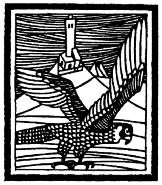
of the Mountain
, the companion of an urban child who runs away to the Catskill mountains to live wild and recapitulate American history as a modern-day Daniel Boone. Another neglected child, tennis prodigy Richie Tenenbaum in Wes Anderson’s 2001 film
The Royal Tenenbaums
, keeps a saker falcon called Mordecai in a mews on the roof of his family home. Set free, Mordecai returns from the New York skies to his fist once an accord is made between father and son. In Victor Canning’s novel
The Painted Tent
, 16-year-old orphan Smiley, on the run from the police, hides out with a west-country circus family and develops a special bond with a caged peregrine in their menagerie. Fria was a falcon who ‘had never known the pure wonder of a peregrine’s real flight . . . the mastery of the air which is the supreme gift of the falcons’.
23
Of all creatures, Smiley ‘loved birds because they seemed to carry the real mean- ing of freedom in their lives’
24
and the peregrine’s captivity oppresses him. Fria escapes, and as the book progresses young Smiley’s gradual personal empowerment is mirrored by Fria’s; she learns hunting skills, revels in the capacity of her freedom; like Smiley she eventually finds a mate.The wizard Ged flies in the form of a falcon: a vignette by Ruth Robbins for Ursula
K. LeGuin’s 1968
fantasy classic
A Wizard of Earthsea
.A poster for Wes Anderson’s 2001 film
The Royal Tenenbaums
.During filming the falcon, held here by Luke Wilson, chased a pigeon across New York and was lost for several days.

Another fatherless child unaware of his true identity, the young King Arthur, is transformed into a merlin by his teacher Merlin in T. H. White’s
The Sword in the Stone
as part of his ‘eddication’. White’s portrayal playfully digs at familiar tropes of medievalism; his talking hawks and his Arthurian armouredknights share a social hierarchy, etiquette and iconography. In the mews of the Castle Sauvage, each hawk or falcon is ‘a motionless statue of a knight in armour’, the birds standing ‘gravely in their plumed helmets, spurred and armed’. The parallels are winningly unsubtle and beautifully couched: ‘The canvas or sacking screens of their perches moved heavily in a breath of wind, like banners in a chapel, and the rapt nobility of the air kept their knight’s vigil in knightly patience.’
25
White gently satirizes the mores of military and sporting elites; before turning the Wart into a merlin and setting him loose into the mews, Merlin suggests that he ‘learn by listening to the experts’ in the martial culture Arthur will have to live and breathe as king. Merlin points out that these falconry birds:don’t really understand that they are prisoners, any more than cavalry officers do. They look on themselves as being dedicated to their profession, like an order of knighthood or something like that. You see, the member- ship of the mews is after all restricted to the raptors, and that does help a lot. They know that none of the lower classes can get in. Their screen perches don’t carry black- birds or such trash as that.
26In the 1930s White himself, an unhappy schoolteacher rent by anxieties over his status, his sexuality and his career, quit his job, took a gamekeeper’s cottage deep in a wood and set about the task of training a hawk. He saw hawk-training as a form of psychoanalysis, treasuring the notion that he might become a feral creature, like the bird he trained. Indeed, falcons’ long, familiar partnership with mankind as falconry birds – often living right inside the most domestic of spheres, the household
– coupled with their resistance to domestication, has allowed
falcons and other birds of prey to become powerfully charged symbols of wildness in many cultures. Falconry has marked mankind’s relation with falcons in myriad robust and decisive ways, and the next chapter explores the phenomenon of what
T. H. White called a ‘rage that you sleep and drink and tremble to think of . . . even in recollection’,
27
and what King James i described as an ‘extreme stirrer up of passions’.
28- Trained Falcons
‘Falconry’s not a sport, it’s a virus’, explained the American falconer. Necks craned upward, we watched his trained pere- grine climb into a late winter sky. ‘A pandemic’, he continued mischievously. ‘Appeared in central Asia thousands of years ago and spread all over the place. By medieval times’, he grinned, ‘you guys in Europe were in the grip of an epidemic way worse than the Black Death.’ His pet theory was succinct, crazy and about par for the course. Falconers routinely pathologize their activity. They say that they never
meant
to be falconers. That they came under the grip of an impulse they couldn’t control.
Once a falconer, always a falconer
was the maxim of nineteenth- century falconer E. B. Michell. I have heard falconers bemoan how falconry has ruined their careers, destroyed their mar- riages and occasioned serious heartache, exertion and expense. And do so happily.Dictionaries define falconry as the use of trained birds of prey to catch wild game. But this singularly fails to capture the social, emotional and historical allure of an activity that has fas- cinated humans for thousands of years and has taken a most extraordinary variety of forms. Centuries ago, Persian falconers flew peregrines at night, catching ducks flushed from moonlit ponds and marshes; they even trained sakers to catch such un- likely quarry as eagles and gazelles. Louis xiii caught sparrows
An iconic falconry image: an imma- ture peregrine, wearing jesses, Lahore bells and a feather-plumed Dutch hood.
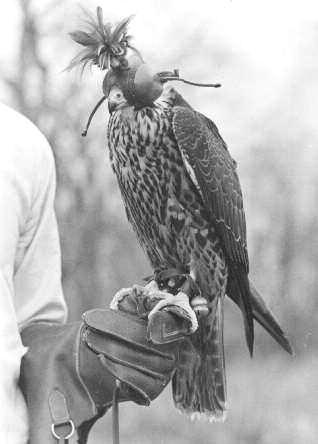
with trained grey shrikes in the gardens of the Louvre; at dusk he hawked bats with peregrines. But in scale, form and social nature, falconry is just as varied a pursuit today. In fragrant desert, American falconers search out the largest and most spectacular quarry for trained falcons, the sagegrouse.
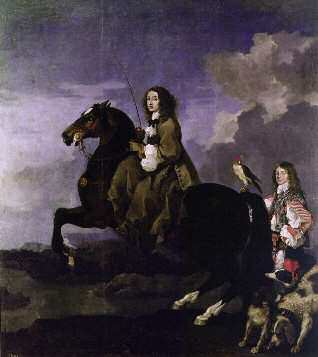
Arab vips land with their falcons in glossy private jets on dedi- cated landing strips in Pakistan. On Scottish moors, tweed-clad and rain-soaked figures tramp across heather to fly red grouse with their peregrines. In Zimbabwe, pupils at Falcon College have even trained falcons as part of their school curriculum.
Some see falconry as an anachronistic pursuit, an irrelevant pastime beloved of historical re-enactment fanatics. It’s easy to see why; media coverage of falconry tends to linger on its ancient and venerable history. But falconry has a vibrant pre- sent. In some countries it’s a part of everyday life: falcons are
Queen Kristina of Sweden
(
r
. 1632–54) andher falconer, in a mid-17th-century oil painting by Sébastien Bourdon.
carried in local marketplaces and malls to tame them in the United Arab Emirates. American falconers see themselves as liv- ing in a new golden age of falconry. In Britain, falconry is more popular today than at any time over the last three centuries: no country show is without its falconry display, and British radio’s oldest soap-opera
The Archers
has its falconer. Falconry centres and schools have opened across Britain and Europe. Inter- national, national and local falconry clubs thrive. The inimitable Martha Stewart, doyenne of American interior design, has even appeared on television with a peregrine on her gloved fist. Whether this is a high or a low point in falconry’s history is moot. Falconry is very much alive.why and when?
Humans have used falcons as hunting partners for at least 6,000 years, perhaps more: no one agrees on when, where or how falconry began. Each falconry culture has its own creation myth that invariably locates the birth of falconry in past soci- eties that reflect its own cultural preoccupations. In 1943, for example, Harvard professor Hans Epstein maintained that fal- conry was a mark of civilization, requiring a ‘wealth of leisure, great patience, sensitivity and ingenuity, not ordinarily shown with regard to animals by primitive people’.
1
He was sure, there- fore, that it could not possibly have a Germanic origin. The Trojans were the first falconers, thought many sixteenth-century Europeans. Nineteenth-century British falconers with good classical educations seized on Pliny’s brief description of Thracian bird-catchers using hawks to drive wild birds into nets as proof that falconry began in ancient Greece, even though Xenophon’s exhaustive essay on Greek hunting,
Cynegeticus
, mentions falconry not once.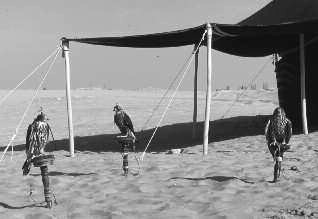
Recent discoveries of raptor bones in Near East palaeo- lithic graves lead some to suggest that falconry has a prehistoric origin. But most modern commentators think that it first arose on the high plateaux of Central Asia. From there it was carried east, arriving in China and Japan in the third century
AD
, and west with trade and invasion all the way to Western Europe. Of course, falconry could have arisen inde- pendently in several places. Cortez reported that Montezuma kept large collections of birds of prey at the Aztec court, although whether or not they were used for falconry is hotly debated. Arab scholars have written that the first man to train a hawk to hunt was al-Harith bin Mu’awiyah bin Thawr bin Kindah, back in pre-Islamic times. Marvelling at a falcon acci- dentally caught in a bird-catcher’s net, he took it home and carried it about perched on his arm. One day the falcon left his arm and caught a pigeon, the next day, a hare – and falconry was born. And falconry has the honour of being sanctioned in the Holy Koran:Young falcons in the desert near Abu Dhabi. Falcon training here takes place in the morn- ing and evening; when the sun’s heat becomes too great, the falcons rest in the shade.

A terracotta figure of a falconer from 6th-century Japan.
They ask you what is lawful to them. Say all good things are lawful to you, as well as that which you have taught the birds and beasts of prey [
Jarih
] to catch, training them as Allah has taught you. Eat of what they catch for you, pronouncing upon it the name of Allah. And have fear of Allah: swift is Allah’s reckoning.In the 1930s British falconer Colonel Gilbert Blaine tried to explain the strange hold falconry had over him and his fellows. He declared that the ‘true falconer is born, not made’. ‘Deeply rooted in the nature of certain individuals [exists] some quality which inspires a natural liking for hawks’, he continued. Musing on what this quality might be, he concluded that it must be ‘an instinct inherited from our ancestors’ who pursued the sport.
2
Rather winningly, Blaine then awards himself and his friends a fortunate lineage. For the ancestors of the modern- day ‘true falconer’ were all aristocrats. ‘No uncultured race has ever attempted to explore [falconry’s] mysteries’, he wrote; ‘even among the cultured peoples the use and possession of the noble falcons were confined to the aristocracy, as an exclusive right and privilege’.
3the falcons in falconry
Blaine’s words are mired deep in his own social preoccupations, but his notion that falcons are aristocratic birds is a constant across most falconry cultures. ‘Their calm behaviour, noble, cool appearance and reliability is what sets the falcons apart from all other hawks’, wrote American falconer Harold Webster in the 1960s, his sentiment well-nigh indistinguishable from that of early modern falconers and loaded with just as norma- tive a social component. ‘It always has and always will. There is
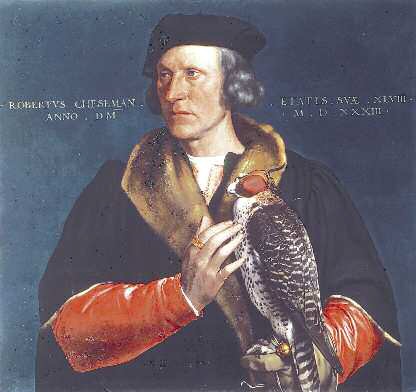
nothing quite comparable to them.’ He described hunting with falcons as a highly social affair, ‘spacious, noisy, spectacular, beautiful and exciting’. And consequently ‘it has its highest appeal to the extrovert who likes to be out with friends and in company’.
4
As in foxhunting today, hawking with falcons in early modern Europe was a grand social occasion requiring a large entourage and vast tracts of land to be seen at its best. And again, Webster is heir to centuries of social positioning inHolding a gyrfalcon, and dressed in sable fur and red leather, this is Robert Cheseman, falconer to Henry viii, in an oil painting by Hans Holbein the Younger, 1533.
falconry when he writes that the man who shuns falcons and prefers hunting with short-winged hawks such as sparrowhawks and goshawks is ‘something of an introvert’ who ‘prefers to go alone to secret, tangled places along creekbanks, hedgerows and field edges’.
5
Indeed, in the thirteenth century,
austringer,
the term for someone who flew hawks rather than falcons, was a term of abuse.
Other books
Flamingo Fugitive (Supernatural Bounty Hunters 5) by E A Price
In The Name Of Love by Rilbury, Jendai
The Best Paranormal Crime Stories Ever Told by Martin H. Greenberg
Remind Me Again Why I Need a Man by Claudia Carroll
The Cottoncrest Curse by Michael H. Rubin
Delphi Complete Works of Anton Chekhov (Illustrated) by ANTON CHEKHOV
Azabache by Alberto Vázquez-Figueroa
The Thin Man by Dashiell Hammett
J.D. Trafford - Michael Collins 03 - No Time To Hide by J.D. Trafford
The Love Affair of an English Lord by Jillian Hunter
